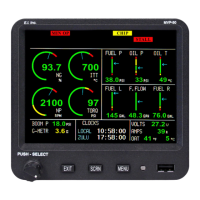5.1 Power-On Checkout:
Turn the aircraft master switch on. The MVP will power up and perform a system test. After approximately 14
seconds, the MVP will display the “Main Engine” screen with an add fuel message. Press any button to continue. If
you have a problem with any of the following steps, see the Troubleshooting section of this manual.
A. Check the N1 and N2 for a reading of 000.
B. Check Fuel Flow for a reading of 00.0.
C. Check Oil Pressure for a reading of 00.
D. Check Oil Temp to read ambient temperature.
E. Check Volts for proper reading.
F. Check Amps for proper reading (000 when monitoring the Gen. Out).
G. Check OAT to read ambient temperature outside the aircraft.
H. Check all Annunciators for proper operation.
I. Check gear indications on the System screen to operate properly.
J. Check all other functions on the Main and System screen to operate properly.
Note: Fuel Level, Trim, Flaps and Pressure Altitude may not read properly until they have been
calibrated.
5.2 Perform all Steps listed in the "MVP-50T Setup Checklist":
A Setup Checklist is provided with your kit. Each step listed in the checklist must be completed before continuing
with this installation.
5.3 Ground Run Checkout:
Before starting the engine, test the N1, N2 and ITT functions for proper operation. If an important function does
not appear proper during any phase of the start, abort the start. Electronics International produces Field Test
Devices that output signals to emulate ITT, N1, N2, Oil Pressure, Fuel Pressure, Oil Temperature, Fuel Flow, shunts
and Resistive and Capacitive Fuel Sensors. These devices can be used to test the wiring, connections, functionality
and accuracy of the MVP system installed in the aircraft. See EI's pricelist for more information. Consider testing the
installation with Field Test Devices before starting the aircraft.
Start the aircraft engine. Follow all the airframe and engine manufacturer's procedures. Check that the values for each
function displayed on the MVP are proper for "engine on" operation. Any problem with a specific function will be
associated with a probe, cable or interconnect between the probe and the EDC for that function. If you have a problem
with any function, see the Troubleshooting section of this manual.
Turn the engine off. Inspect the entire system for interference with controls, loose fittings, connections, clamps,
probes, and inspect for leaks, chafing, obstructions, heat damage and any thing that may cause unsafe flight. Check
that all fittings are tight.
39

